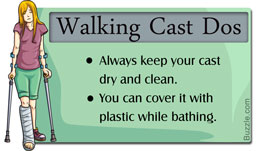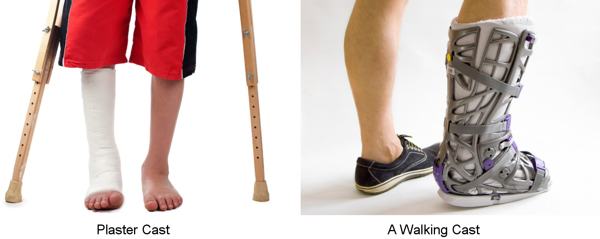Walking casts are recommended by doctors to make it easier for you to walk you have suffered a lower leg injury. There are some dos and don'ts while using it. Buzzle helps you become aware by providing you with some simple instructions for using a walking cast.

Some Help for Your Injury
- Injury affects a person physically and mentally. It will be frustrating no doubt, but make sure that you don't hurt your family and friends, who are the only ones who'll be there with you.
- Keeping a positive attitude will help you a lot.
- Plan out fun activities to distract yourself from the pain and boredom.
Casts are important for injuries and fractures. They keep the broken bones intact and prevent them from any further destruction. The type of the cast depends on where it is used, like the arm, leg, etc. Casts can be of different materials and sizes. Casts are basically made of two things; one is made from Plaster of Paris, which is white, and the other is of fiberglass, which comes in varied colors and designs. There are waterproof casts available too. The outer part is the plaster or fiberglass and the inside part is cotton, which makes it comfortable for the patient.Walking Casts

Walking casts are a firm support that help you in moving when you're injured as well as to heal the injury. There are two types: a walking cast and a non-walking cast.
- A non-walking cast is when you have to entirely keep your weight off the affected leg by using crutches.
- A walking cast helps you to move around with the affected leg. Sometimes, you will need to use crutches. They are soles or boots on the molded cast. There are varieties in this too. Your doctor will give you the appropriate type.
You Should ...✓ Attempt to walk with the cast only when it is fully dry. A fiberglass cast will dry in an hour, but a plaster will take 2 - 3 days.
✓ Try out the walking cast and see if it's comfortable. Adjust the Velcro accordingly. It shouldn't be too tight or too loose.
✓ Walk normally. The walking cast is made in such a way that it will take your weight. The doctor will tell you how to balance your weight at first.
✓ Try to keep away dirt or any small particles from going inside your cast.
✓ Keep the cast dry. While bathing, use a plastic or get a waterproof shield. Moisture will cause irritation.
✓ Raise the level of your leg (the part that is in the cast) above the heart level, after the cast is applied.You Should Not ...✘ Use anything to scratch yourself inside the cast. This can cause pain. If the irritation grows, consult a doctor.
✘ Place a hard support under the wet plaster. It will cause a dent. You can use a pillow or any support that's soft.
✘ Walk around with boots, unless you are asked to. It will harm the cast and may aggravate your injury.
✘ Pull out the padding of the cast.
✘ Try to remove or trim the cast without asking your doctor.See Your Doctor If ...✚ The skin around the cast turns red.
✚ There are cracks. If it happens, it's maybe time you got a new one for you.
✚ The cast becomes too tight or too loose, or if you feel the pressure from within.
✚ There is odor emanating from the cast, except for the sweat odor (which is normal).
✚ You feel a stinging sensation, excessive pain, or excessive swelling.Take proper care and listen to all your doctor's instructions. Be strong and positive. This stage will pass off very soon, and before long, you'll start your routine. But yes, do take care even after the cast is off for some time. We wish you a speedy recovery!


 Some Help for Your Injury
Some Help for Your Injury
 Walking casts are a firm support that help you in moving when you're injured as well as to heal the injury. There are two types: a walking cast and a non-walking cast.
Walking casts are a firm support that help you in moving when you're injured as well as to heal the injury. There are two types: a walking cast and a non-walking cast.